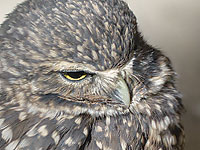 Early settlers traveling across the Great Plains nicknamed the small, charismatic ground nesting owl that witnessed the westward expansion of covered wagons from the lip of its burrow, the howdy owl or prairie dog owl. Other early names included Billy owl or ground owl but nowadays, they are known as burrowing owls.
Early settlers traveling across the Great Plains nicknamed the small, charismatic ground nesting owl that witnessed the westward expansion of covered wagons from the lip of its burrow, the howdy owl or prairie dog owl. Other early names included Billy owl or ground owl but nowadays, they are known as burrowing owls.
These owls are unique for several different reasons.
First, burrowing owls are the only owl species that nests underground. The owls utilize abandoned badger or prairie dog homes in the Canyonlands area for nest sites. In Texas, abandoned armadillo burrows may be used; in other regions ground squirrel or desert tortoise burrows might fit their need. Across their range, which spreads from the prairie areas of Western Canada to Florida (mainly the western states) and into South America, these owls have also been known to use artificial burrows – buried plastic pipe which connects to a plastic chamber. Of course, they have the ability to excavate their own burrows; burrowing owls in Florida have been clocked creating a 10-foot-long burrow in just two days.
Second, burrowing owls are diurnal, active during daylight hours, although they can also hunt at night. During the heat of summer, the early morning or late afternoon hours constitute the height of their activity. When alarmed outside their burrows, the owls may bob up and down and fluff their feathers to appear larger than they are.
Another unique aspect of these owls is that the males are slightly larger than the females (although the females tend to be heavier), a trait that is reversed for the majority of birds of prey.
Because the birds nest in open country such as grasslands or in openings in sagebrush or other shrublands, they prey on beetles, grasshoppers, lizards, small snakes, toads, and rodents. Scorpions may be hunted at night. And at the nest site, the adult owls may bring dung back to near their burrow entrances. This habit was once thought to mask their nest site aroma, but now scientists believe this is to lure dung beetles closer to the burrow which the birds consume. This concept of using a tool, the dung, to attract prey is fairly unique in bird behavior.
Dung isn’t the only object the birds haul back to their burrows. Feathers, shredded paper, plastic bags, or dried horse manure might adorn their burrow’s entrance. These owls are the packrats of the avian world.
When threatened by a predator, the owls may retreat to the protective confines of their burrow. If the predator such as a kit fox or badger gets too close, the young owls mimic the sound of a rattlesnake’s hiss to hopefully warm away the predator. If a burrowing owl nests within a prairie dog town, it relies upon the vigilance of its neighbors to warn them of potential dangers.
Like many of their relatives, burrowing owls have mottled plumage and at 7-10 inches tall, these ground-dwelling birds don’t tower over the landscape. They often perch on the lips of their burrow or a nearby cow patty or fly to a fence post or shrub for a better vantage point.
Of the 250 owls found worldwide, four are in the Athene genus and only one, Athene cunicularia occurs in North America. Athena was the Greek goddess of wisdom and warfare and cunicularia means “little miner” after the bird’s habit of going underground, a wise choice for this desert-dwelling creature.